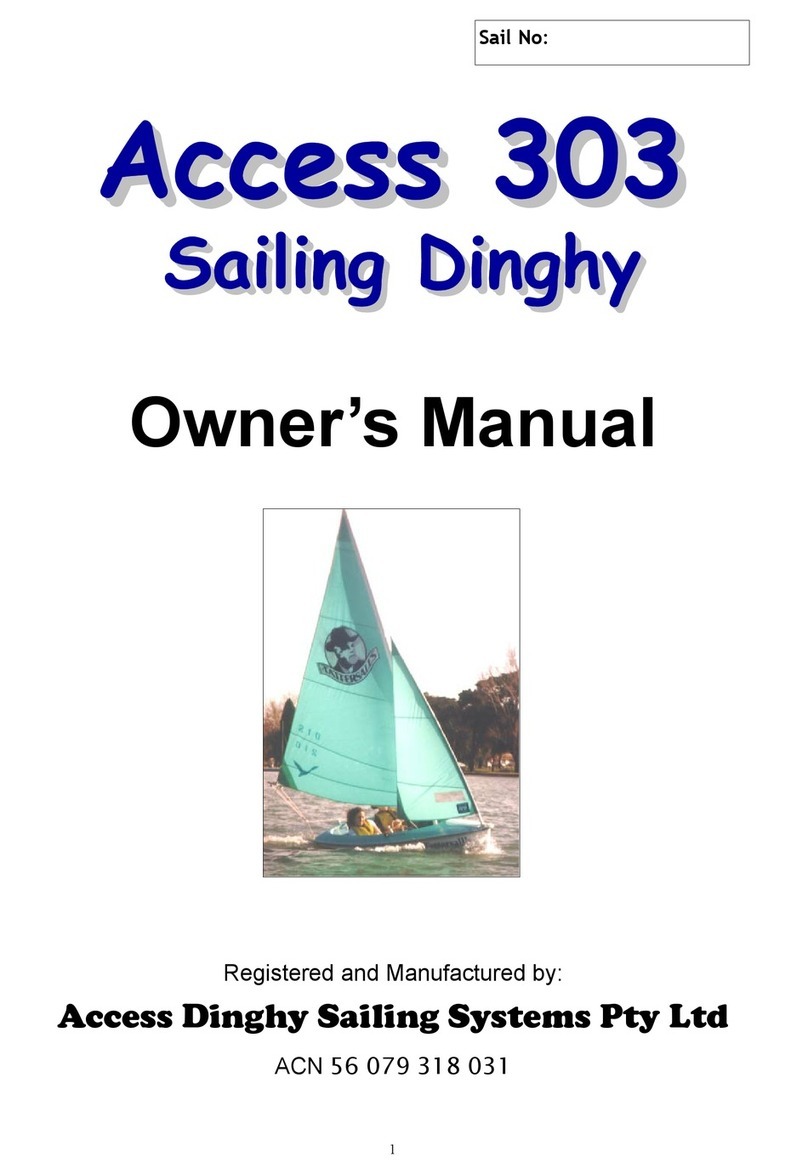Items included with your Access 303S Sailing Dinghy.
1. Sailing Dinghy 11. Mainsail
2. Mast 12. Foresail (Jib)
3. Fors’l Mast 13. Bobbin
4. Boom 14. Mainsheet
5. Centreboard 15. Main Outhaul
6. Rudder Blade 16. Jib sheet
7. Rubber Box 17. Jib Claw
8. Rudder Box Pin 18. Jib Strut
9. Traveller 19. Jib Downhaul
10. Painter.. 20. Installed reefing system,
both masts.
General Safety Sailing Precautions
GENERAL
•Take into account the actual and forecast weather conditions.
•Personal Flotation Devices (PFD) must be worn by all persons when afloat.
•The sailing area should be clearly defined and known to all afloat. The safety
boat should be able to view the entire sailing area at all times.
•There should be a simple signal for all boats to return to shore, which is
known by all afloat.
•The safety of sailors and volunteers must be considered at all time. If
weather conditions alter, sails are to be reefed accordingly, or if necessary
activities cancelled should conditions prove unsafe.
SAFETY BOAT
•When Access Dinghies are sailed a safety boat should be on the water at all
times, with at least two crew on board. Generally a safety boat should pro-
vide cover for no more than eight dinghies, but prevailing conditions must be
taken into account.
•Safety boats should carry a first aid kit and should be equipped with radio
communication to the shore.
•In all planing powerboats, a kill cord should be fitted and used.
•All persons in the safety boat must wear an approved buoyancy aid.
•All safety boat personnel should be instructed on how to reef sails.
•If an Access Dinghy needs to be towed, it is safer and easier to tie the
dinghy close alongside and remove the rudder blade so that the dinghy
cannot be “steered” in the wrong direction.
Design Features of Access Dinghies
Access Dinghies are designed with a hull form and other features which
combine to give considerable stability. There needs to be a set of rules
which we must follow to continue our excellent safety record and prevent
any accidents. The stability of Access 2.3 and 303 Dinghies is reliant upon
the following factors.
•SEATING - Because the placement of sailor’s weight affects stability it is
important that people remain seated low in the boat. We therefore, have
to look at using quick release velcro straps to hold them in place, pro-
vided the keel is locked fully down.
•CENTREBOARDS - It is most important that the keel be fully down
when sailing. The hole 1/3 down the keel is there purely to facilitate
sailing off a beach, and under no circumstances should people with
disabilities be allowed to sail around with the keel held in this posi-
tion. There is provision to lock the keel fully down so as even in a
“knock down” it remains in place. It is imperative that the locking pin be
inserted whenever the boat is used. Invariably people sailing the electric
boat need to be strapped into it. Never strap someone into a boat
unless the centreboard locking pin is inserted through the c/b handle.
Locking the keel— Insert the long aluminium pin
through the c/b handle and into the drilled hole in the
console. Push the pin right in so that only the knot at
the end of the rope is visible.
•REEFING - Being a displacement type hull extra sail area in strong
winds does not mean more speed, all it does is bury the boat in the wa-
ter and make it more difficult to handle. In a breeze it is always better to
reef to suit the stronger gusts.
If an Access Dinghy needs to be towed, it is safer and easier to tie the din-
ghy close alongside and remove the rudder blade so that the dinghy cannot
be “steered” in the wrong direction.
A pontoon system which will take care of the off the beach keel handling
and transferring problems is available from Access Dinghies.
People with disabilities need the keel down and because many are unable
to raise and lower the keel to improve sailing performance and also unable
to adjust the size of the sail by reefing it is discriminatory to allow abler bods
to make these adjustments during a race.






















